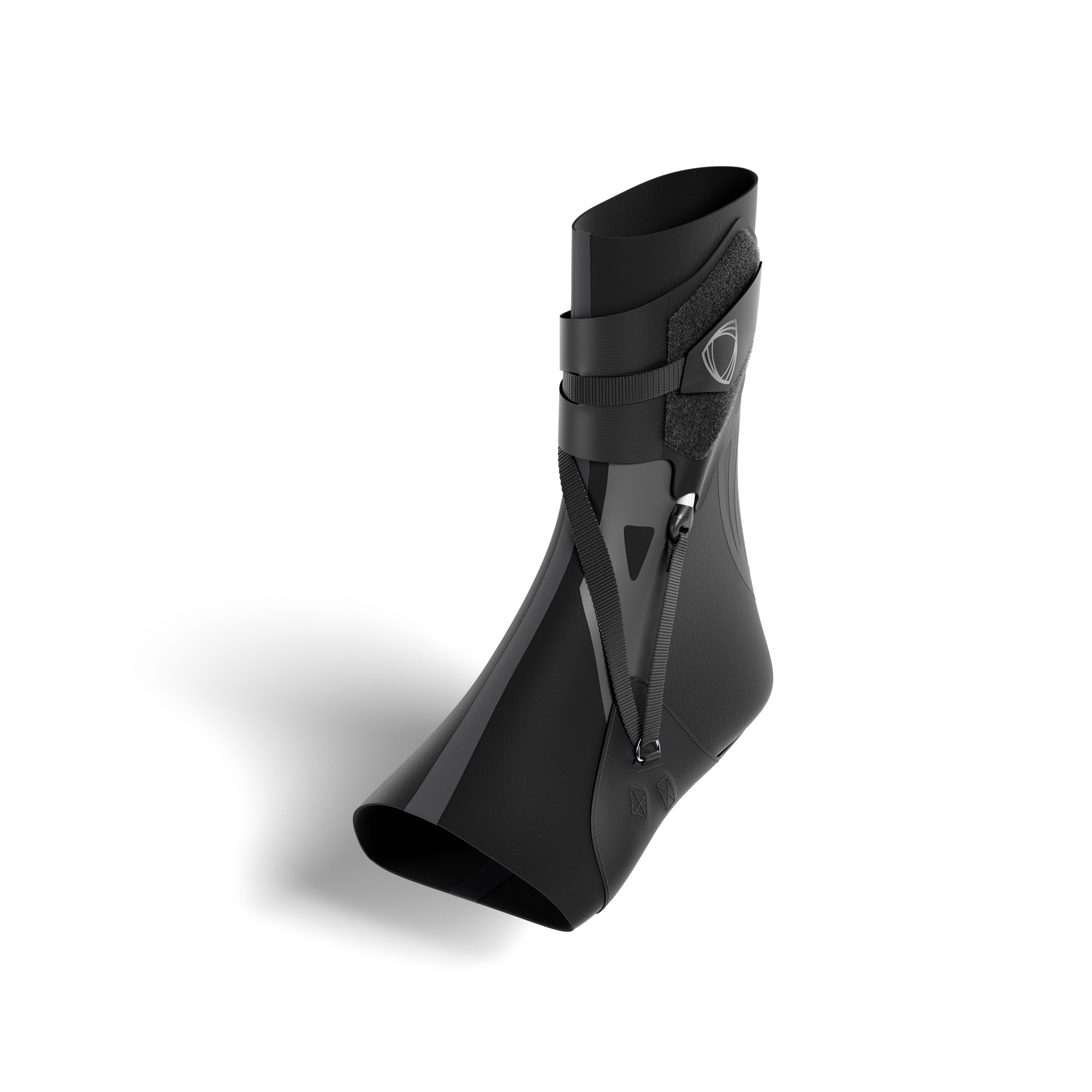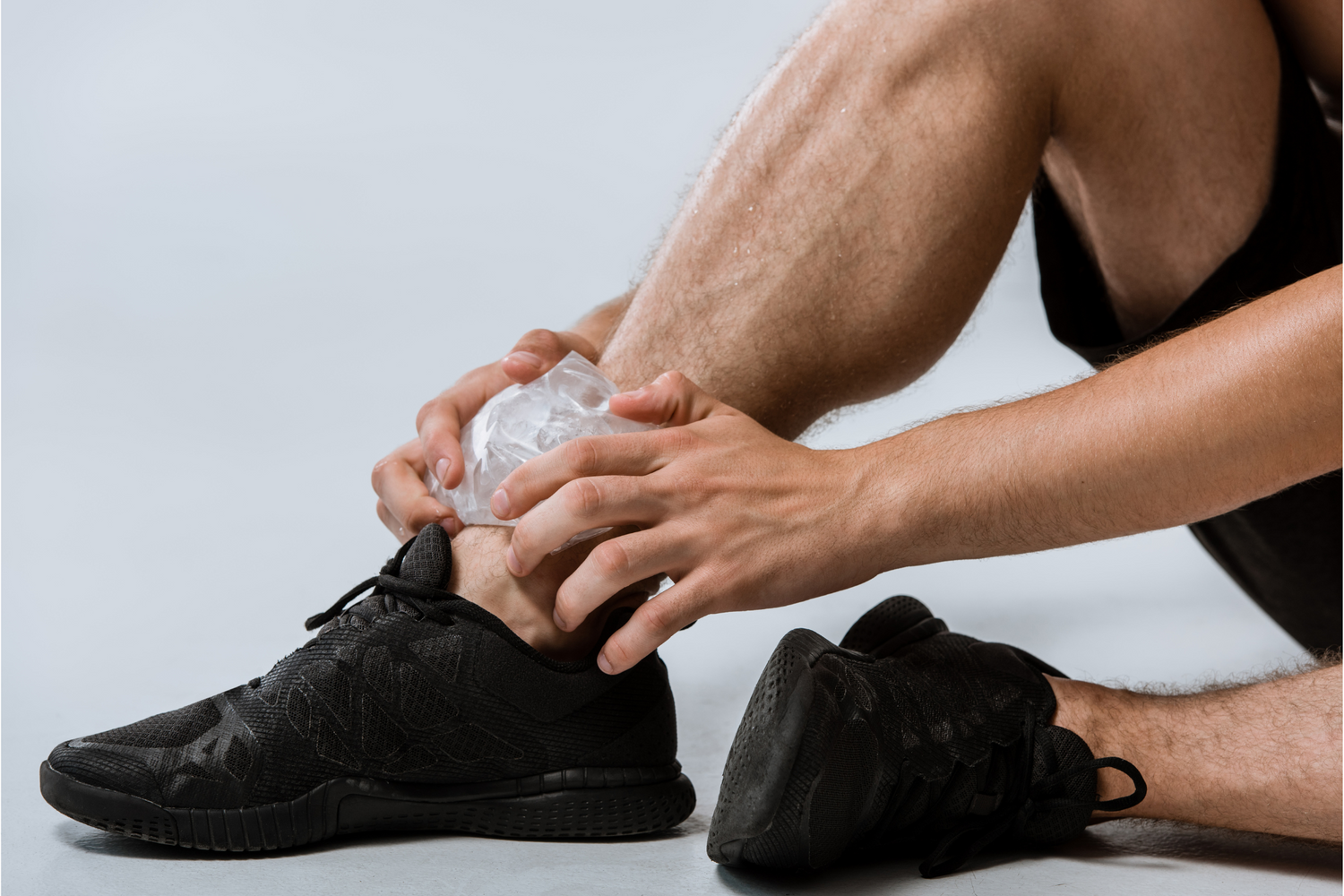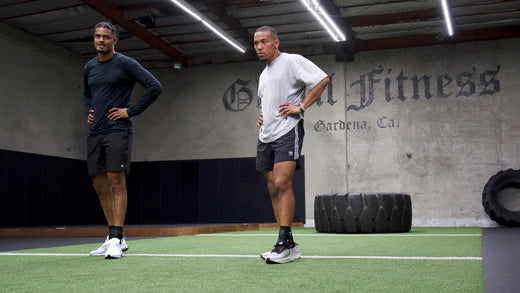Have you twisted your ankle while playing sports or going about your daily routine? Now it's important to treat it properly. For minor injuries, renowned sports physician Dr. Lukas recommends the RICE method, which you can use to treat a twisted ankle yourself. For more serious injuries, it may be necessary to see a doctor. This article will help you make the right decision.
Twisted ankle: What to do?
To save time and take appropriate action, you should examine your foot carefully and observe your symptoms. There are different degrees of severity when it comes to twisted ankles.
Minor injury: Ligament strain or overstretching
The ligaments that stabilize your ankle have been slightly overstretched by the sprain, but are not torn.
Symptoms:
- Mild pain in the ankle, especially when moving
- Minimal or no swelling
- No visible bruising
- The foot is stable and can bear weight despite mild discomfort.
Treatment:
If you have a ligament strain, you do not need to see a doctor immediately. You can also apply the RICE method yourself. If the discomfort persists or even worsens after the first 24-48 hours following the injury, consult a doctor.

Moderate injury: partial tear of the ligaments
Part of your ligaments were damaged when you twisted your ankle, but the other part is still intact. Your ankle feels noticeably unstable.
Symptoms
- Moderate to severe pain in the ankle
- Significant swelling around the ankle, often within a few hours
- Bruising is visible after 1-2 days
- Mobility and weight-bearing are limited
- You feel instability and wobbliness in your ankle
Treatment
If you experience the above symptoms in your ankle or ankle joint, you should definitely see a doctor. They will diagnose the exact injury, assess the swelling, and rule out any possible accompanying injuries. In the case of a partial tear, you may need a splint, medication, and/or physical therapy, which involves exercises to promote mobility, coordination, and muscle strength.
Severe injury: Complete ligament tear
A complete ligament tear occurs when one or more ligaments in the ankle joint are completely torn. Your ankle suffers from significant instability and you may have accompanying injuries.
Symptoms
- The pain occurred suddenly and intensely, often accompanied by a cracking sound when the ankle was twisted.
- Severe swelling that increases rapidly
- Usually a large bruise that spreads in the days after the injury
- Significant instability; your foot can hardly bear any weight
- Restricted range of motion. Your foot can no longer be fully bent or stretched.
Treatment
If you experience these symptoms during and after twisting your ankle, a medical examination is essential. In most cases, you will be given a splint or cast. In severe cases, surgical stabilization may also be necessary.
Twisted ankle - The RICE method supports healing

Orthopedic surgeon and sports physician Dr. Lukas has been treating professional teams in handball, basketball, and soccer for over 20 years. Treating sprained ankles and ankle injuries is part of his standard repertoire. He explains: “If your foot is sprained, your ankle is swollen and perhaps even discolored, you should apply the so-called RICE rule immediately after the sprain.” The name of this rule also outlines the individual measures to be taken. Dr. Lukas has four specific tips on how to treat a sprained foot immediately after the injury occurs. Here are his expert tips:
1. R for Rest
If your foot has twisted outward, you should under no circumstances continue training or playing. This also applies if your foot twists but you do not feel any pain immediately after the twist. It is important to get an adequate diagnosis as soon as possible. This will prevent the injury from getting worse.
2. I for ice
Twisted foot – cool it down! It doesn't necessarily have to be ice. A cold spray, for example, also helps to minimize swelling or bruising. Sponges soaked in ice water with an Ideal bandage are also ideal for cooling. This is known as “hot ice.” If you use ice or cool packs, make sure they do not come into direct contact with the skin. This has a negative effect, as blood is sent to the area after the cooling is removed to balance the temperature.
3. C for compression
At the same time, a light pressure bandage should be applied. This immobilizes the joint and reduces the swelling caused by the hematoma. You should also bandage the sprained foot later on.
Instructions: Applying a compression bandage correctly
A correctly applied compression bandage reduces swelling and slightly stabilizes the joint without restricting blood flow. Hold the foot in a 90° position after you have prepared the necessary materials. Here is a step-by-step guide on how to apply the compression bandage correctly.
- Padding: Lightly cover sensitive areas (e.g., ankles) to avoid pressure points.
- Start: Begin with a wrap around the midfoot – band smooth, without wrinkles.
- Wrapping: Lead each layer upward, overlapping by about half.
- Figure-8 technique: Band over the back of the foot, under the foot, and around the ankle—this creates a supportive figure-8 shape.
- Continue: Wrap upward toward the calf until the foot and joint are securely bandaged.
- Secure: Secure the end with a clip, Velcro, or tape.
- Check pressure: Are your toes warm and rosy? No tingling or numbness? If not, loosen the bandage.
- Check: Check regularly during the first few hours and reapply if necessary.
Wearing time: Wear during the day for the first 24–48 hours, loosening during rest periods. If you suspect a torn ligament, consult a doctor.

4. H for Elevation
A sprained foot must always be elevated above heart level in order to effectively combat swelling. This applies both immediately after the injury and during the subsequent recovery process.
Protect your ankles from sprains while playing sports
We developed The BetterGuard to minimize the risk of sprains and lateral joint injuries during sports. Wear the smart ankle brace during play and experience how it supports you during critical movements. If your foot is in danger of twisting, the mini piston in the brace reacts immediately and stabilizes your lateral ligament before a painful accident occurs.

Further information: Typical symptoms of a sprained ankle
Swelling usually occurs immediately, sometimes accompanied by severe pain. If the ankle is sprained, bruising usually occurs as well. You can quickly recognize this by the typical blue discoloration around the ankle. This discoloration is caused by bleeding into the tissue.
Typical symptoms of a sprained ankle:
- Acute, sharp pain immediately after spraining the ankle
- Visible swelling in the ankle or instep area
- Bruising or bluish discoloration (hematoma)
- Restricted movement or instability when walking
- Pressure sensitivity on the outside of the ankle
- In more severe cases: cracking or tearing at the moment of injury
However, it is not always necessarily one or more torn ligaments. Sprains and strains also cause severe pain when you twist your foot. Only a precise diagnosis by a specialist can reveal the nature and severity of the injury. In any case, you should immediately initiate first aid measures if your foot is twisted, swollen, and possibly even discolored.
Twisted ankle: What consequences you can expect
If you twist your ankle, this often leads to swelling and pain. However, these are only the initial symptoms. Twisting movements can also cause more serious injuries. Doctors refer to this type of injury as supination trauma. This occurs when the foot twists inward while the body weight is shifted outward. The outer ligaments (the ligaments on the outside of the ankle) are severely stretched or even torn.
In most cases, at least one of the three ligaments that are in direct contact with the ankle joint is injured. The severity and duration of such an injury depends primarily on how quickly and severely the foot twists. Ankle injuries are particularly common in sports that involve frequent jumping and quick changes of direction.
This is especially true in soccer, handball, and other ball sports, but it is also a recurring movement in trail running, gymnastics, and tennis. This was experienced, for example, by former professional handball player Kevin Struck (Füchse Berlin, VfL Potsdam). His ordeal lasted a total of six months after he twisted his ankle at the Club World Cup in Doha in 2018.
Questions athletes often ask themselves when they twist their ankle
Twisting your ankle and not being able to identify the symptoms can be unsettling. Here you will find answers to questions that many people often ask themselves.
What could it be: twisted ankle, no swelling, but pain?
If you twist your ankle but there is no swelling, it may be a mild ligament strain or sprain. This means that the stabilizing ligaments of the ankle joint have been stretched but not torn. Pain often occurs during movement or when putting weight on the foot, but this subsides after a while. If the pain persists or becomes more severe, it is advisable to see a doctor.
When should you see a doctor after twisting your ankle?
A visit to the doctor is necessary if:
- the pain is severe and does not subside
- there is significant swelling or bruising
- the foot is unstable or can hardly bear weight
- you feel that your foot is buckling or collapsing
- you heard a cracking sound when you twisted your ankle
If you are unsure or have persistent symptoms, it is always advisable to seek medical advice.
How can I recognize a torn ligament?
A torn ligament often manifests itself through the following symptoms:
- Sudden, severe pain, usually accompanied by a cracking sound when twisting
- Rapidly increasing swelling
- Bruising that spreads after one to two days
- Noticeable instability; your foot feels unsteady
- Limited mobility; you can hardly bend or stretch your foot
A doctor can make a clear diagnosis through clinical tests and, if necessary, imaging (e.g., MRI).
When should you tape a sprained foot?
Taping can be useful if:
- The injury is minor (e.g., a ligament sprain) and you want to resume sports activities
- You have already had an ankle injury and are looking for additional protection
- You want to stabilize your ankle preventively to avoid spraining it again
In the case of a torn ligament or severe symptoms, taping alone is not enough – a splint or targeted therapy is necessary. Alternatively, The BetterGuard offers a modern solution: an intelligent ankle brace that adapts flexibly and only stabilizes you when necessary.
How long does it take for a sprained ankle to heal?
The healing time depends on the severity of the injury. In the case of a slight sprain or overstretching of the ligaments, it usually takes one to two weeks before the foot can bear weight again. A partial tear or complete ligament tear, on the other hand, can take four to six weeks or longer. Consistent rest, compression, and, if necessary, physical therapy are crucial.
How can you tell if a ligament in your foot is torn?
A torn ligament is usually noticeable by a sudden, sharp pain and an audible crack or tear at the moment of injury. Shortly afterwards, rapid swelling and often significant bruising occur. The foot feels unstable and can hardly bear any weight. A medical examination with ultrasound or MRI provides definitive certainty.






